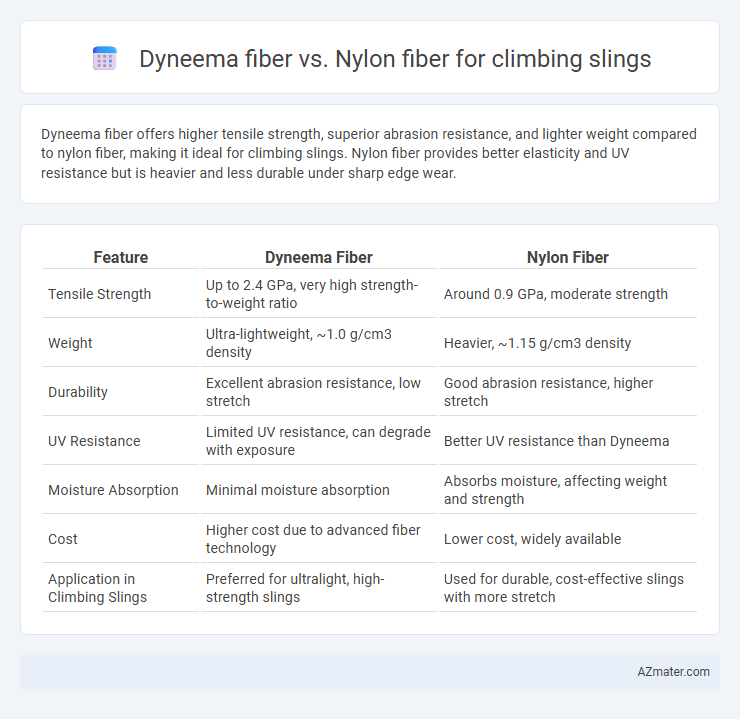Dyneema fiber offers higher tensile strength, superior abrasion resistance, and lighter weight compared to nylon fiber, making it ideal for climbing slings. Nylon fiber provides better elasticity and UV resistance but is heavier and less durable under sharp edge wear.
Table of Comparison
| Feature | Dyneema Fiber | Nylon Fiber |
|---|---|---|
| Tensile Strength | Up to 2.4 GPa, very high strength-to-weight ratio | Around 0.9 GPa, moderate strength |
| Weight | Ultra-lightweight, ~1.0 g/cm3 density | Heavier, ~1.15 g/cm3 density |
| Durability | Excellent abrasion resistance, low stretch | Good abrasion resistance, higher stretch |
| UV Resistance | Limited UV resistance, can degrade with exposure | Better UV resistance than Dyneema |
| Moisture Absorption | Minimal moisture absorption | Absorbs moisture, affecting weight and strength |
| Cost | Higher cost due to advanced fiber technology | Lower cost, widely available |
| Application in Climbing Slings | Preferred for ultralight, high-strength slings | Used for durable, cost-effective slings with more stretch |
Introduction to Climbing Slings: Importance of Material Choice
Climbing slings rely heavily on material strength, durability, and weight, with Dyneema fiber offering exceptional tensile strength and low stretch compared to traditional Nylon fiber. Dyneema's high resistance to abrasion and moisture makes it ideal for maintaining performance in harsh climbing environments, whereas Nylon provides better elasticity and impact absorption under dynamic loads. Selecting the appropriate fiber directly impacts safety, longevity, and climbing efficiency, making the material choice crucial for creating reliable and high-performing climbing slings.
Dyneema Fiber Overview: Properties and Characteristics
Dyneema fiber is a high-performance polyethylene material known for its exceptional strength-to-weight ratio, making it significantly stronger and lighter than nylon fiber in climbing sling applications. Its low stretch and high resistance to abrasion, UV exposure, and moisture enhance durability and reliability during critical climbing maneuvers. Unlike nylon, Dyneema offers superior resistance to chemical degradation and minimizes sling elongation, contributing to improved safety and performance in technical climbing scenarios.
Nylon Fiber Overview: Properties and Characteristics
Nylon fiber offers high tensile strength, excellent abrasion resistance, and significant elasticity, making it a durable choice for climbing slings that require flexibility and shock absorption. It retains good performance under wet conditions due to its ability to absorb moisture without substantial strength loss, providing reliable security during climbs. Nylon's resilience and stretchability contribute to energy dissipation during falls, enhancing climber safety compared to stiffer fibers like Dyneema.
Weight Comparison: Dyneema vs Nylon for Climbing Slings
Dyneema fiber is significantly lighter than nylon, with a density of approximately 0.97 g/cm3 compared to nylon's 1.15 g/cm3, making Dyneema-based climbing slings notably more weight-efficient. This low weight contributes to reduced overall pack weight and improved ease of maneuvering during climbs, enhancing performance especially in high-altitude or multi-pitch ascents. While nylon offers more stretch and durability in abrasion-prone environments, Dyneema's ultra-light properties make it the preferred choice for climbers prioritizing minimal weight without compromising tensile strength.
Strength and Load-Bearing Capacity
Dyneema fiber offers significantly higher tensile strength and load-bearing capacity compared to Nylon fiber, making it ideal for climbing slings that require maximum performance under extreme stress. Dyneema's strength-to-weight ratio surpasses Nylon, enabling lighter and more compact slings without compromising durability. Nylon fibers exhibit greater elasticity, which can absorb shock loads better but at the cost of lower overall strength and increased weight.
Durability and Longevity in Climbing Applications
Dyneema fiber offers superior durability and longevity compared to nylon fiber in climbing slings due to its exceptional resistance to abrasion, UV exposure, and moisture, which prevents weakening over time. Nylon fiber, while more flexible and elastic, tends to degrade faster under harsh environmental conditions, resulting in reduced lifespan and more frequent replacement needs. Climbers prioritize Dyneema slings for long-term reliability and enhanced safety on demanding routes.
Resistance to Abrasion, Moisture, and UV Exposure
Dyneema fiber offers superior resistance to abrasion compared to nylon, making it more durable for climbing slings exposed to rough surfaces. It also has excellent moisture resistance, as it does not absorb water, maintaining strength and reducing weight in wet conditions, unlike nylon which can retain moisture and weaken. UV exposure affects Dyneema less severely--its fibers degrade slower under prolonged sunlight, whereas nylon is more susceptible to UV damage, compromising the sling's lifespan.
Handling and Knotability: Dyneema vs Nylon
Dyneema fiber offers superior abrasion resistance and a lower stretch profile compared to nylon, making it ideal for climbing slings requiring minimal elongation under load. However, Dyneema's slick surface reduces friction, resulting in decreased knot holding ability and increased difficulty in tying secure knots. Nylon fibers, with higher elasticity and greater surface friction, provide easier handling and more reliable knot security, though they are heavier and less resistant to abrasion than Dyneema.
Price and Value Considerations
Dyneema fiber offers superior strength-to-weight ratio and high abrasion resistance, making it a premium choice for climbing slings but comes at a higher price compared to nylon fiber. Nylon fiber slings are more affordable and provide excellent elasticity and durability, enhancing shock absorption during falls, which contributes to overall safety at a lower cost. Evaluating value involves balancing Dyneema's lightweight performance against nylon's cost-effectiveness and flexibility, depending on specific climbing needs and budget constraints.
Choosing the Best Fiber for Your Climbing Needs
Dyneema fiber offers superior strength-to-weight ratio and high resistance to abrasion, making it ideal for ultra-lightweight climbing slings that demand durability and performance. Nylon fiber provides greater elasticity and shock absorption, which can be beneficial for dynamic climbing situations where energy dissipation is crucial. Selecting the best fiber for your climbing needs depends on prioritizing either lightweight strength and low stretch (Dyneema) or impact resilience and flexibility (Nylon).

Infographic: Dyneema fiber vs Nylon fiber for Climbing sling
 azmater.com
azmater.com